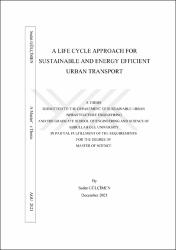| dc.contributor.author | Gülçimen, Sedat | |
| dc.date.accessioned | 2022-08-22T13:22:17Z | |
| dc.date.available | 2022-08-22T13:22:17Z | |
| dc.date.issued | 2021 | en_US |
| dc.date.submitted | 2021-11-29 | |
| dc.identifier.uri | https://hdl.handle.net/20.500.12573/1353 | |
| dc.description.abstract | The objective of this thesis study is to evaluate the sustainability of the urban transport system in Kayseri. In the first part, a life cycle sustainability assessment (LCSA) of the tramway system was performed using a cradle‐to‐grave approach by integrating the environmental, economic, and social aspects for the case of Kayseri, Turkey. The LCSA results revealed that the operation and maintenance phase were determined as the main contributor to the environmental load of the tramway system within its entire life cycle. For economic assessment, the main contributor to the total life cycle cost was energy cost. In the social performance evaluation, it is found that the industry performs well for society, the local community, and workers but has a weaker social performance for the consumer due to a weak feedback mechanism. In the second part, urban transport alternatives were evaluated with the integration of Hesitant Fuzzy Analytical Hierarchy Process (HF-AHP) and Multiple Attribute Utility Models (MAUT) methods. Eight sustainable transport indicators were selected and the weights of selected indicators are calculated with the utilization of HF-AHP. Based on HF-AHP results, the number of fatalities/injuries has been determined as the most significant indicator among the eight indicators with 0.158 normalized weight. Then, twelve urban transport alternatives were ranked by using the MAUT method to decide the most sustainable urban transport alternative. The results of this integrated methodology present that alternative 11, which is dominated by low-motorized vehicles, has been determined as the best sustainable alternative and alternative 1 is the worst sustainable alternative which is dominated by high-motorized vehicles with 0.69 and 0.27 of total utility values, respectively. | en_US |
| dc.description.tableofcontents | 1. INTRODUCTION .................................................................................................... 1
1.1 GENERAL ................................................................................................................. 1
1.2 OBJECTIVES AND SCOPE........................................................................................... 2
2. LITERATURE REVIEW ........................................................................................ 4
2.1 SUSTAINABLE TRANSPORT....................................................................................... 4
2.1.1 Indicators of Sustainable Transport ................................................................ 5
2.1.2 Challenges in Sustainable Transport............................................................... 8
2.2 LIFE CYCLE SUSTAINABILITY ASSESSMENT (LCSA)............................................... 9
2.2.1 Life Cycle Sustainability Assessment in Transport Systems.......................... 10
2.2.2 Multi-Criteria Decision Making Methods in LCSA of Transport Systems.... 13
3. METHODOLOGY ................................................................................................. 16
3.1 DESCRIPTION OF TRAMWAY SYSTEM IN KAYSERI.................................................. 16
3.2 LIFE CYCLE SUSTAINABILITY ASSESSMENT........................................................... 17
3.2.1 Environmental Life Cycle Assessment (E-LCA) ............................................ 17
3.2.2 Life Cycle Costing (LCC) .............................................................................. 24
3.2.3 Social Life Cycle Assessment (S-LCA)........................................................... 25
3.3 MULTI-CRITERIA DECISION-MAKING (MCDM).................................................... 28
3.3.1 Hesitant Fuzzy Analytical Hierarchy Process (HF-AHP)............................. 28
3.3.2 Multi-Attribute Utility Theory (MAUT)......................................................... 30
3.3.3 The Applied Methodology for Sustainable Transport Measurement............. 31
4. RESULTS AND DISCUSSION ............................................................................. 33
4.1 LIFE CYCLE SUSTAINABILITY ASSESSMENT........................................................... 33
4.1.1 Environmental Life Cycle Assessment (E-LCA) ............................................ 33
4.1.2 Life Cycle Costing (LCC) .............................................................................. 36
4.1.3 Social Life Cycle Assessment (S-LCA)........................................................... 38
4.2 MULTI-CRITERIA DECISION-MAKING (MCDM).................................................... 40
4.2.1 Hesitant Fuzzy Analytical Hierarchy Process (HF-AHP)............................. 40
4.2.2 Multi-Attribute Utility Theory (MAUT)......................................................... 43
4.2.3 Sensitivity Analysis ........................................................................................ 49
5. CONCLUSIONS AND FUTURE PROSPECTS ................................................. 51
5.1 CONCLUSIONS........................................................................................................ 51
5.2 SOCIETAL IMPACT AND CONTRIBUTION TO GLOBAL SUSTAINABILITY................... 53
5.3 FUTURE PROSPECTS ............................................................................................... 54 | en_US |
| dc.language.iso | eng | en_US |
| dc.publisher | Abdullah Gül Üniversitesi / Fen Bilimleri Enstitüsü / Sürdürülebilir Kentsel Altyapı Mühendisliği Ana Bilim Dalı | en_US |
| dc.rights | info:eu-repo/semantics/openAccess | en_US |
| dc.subject | urban transport | en_US |
| dc.subject | sustainability | en_US |
| dc.subject | life cycle | en_US |
| dc.subject | multi-criteria decision making | en_US |
| dc.title | A life cycle approach for sustainable and energy efficient urban transport | en_US |
| dc.title.alternative | Sürdürülebilir ve enerji verimli kent içi ulaşım için yaşam döngüsü yaklaşımı | en_US |
| dc.type | masterThesis | en_US |
| dc.contributor.department | AGÜ, Fen Bilimleri Enstitüsü, Sürdürülebilir Kentsel Altyapı Mühendisliği Ana Bilim Dalı | en_US |
| dc.relation.publicationcategory | Tez | en_US |


















